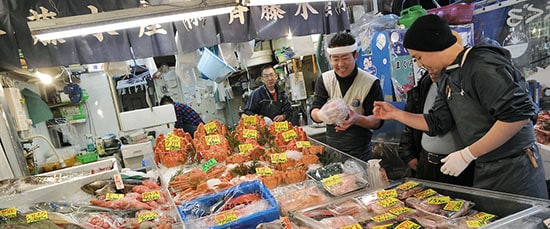
The motive for the move? To free up the valuable real estate for more profitable ventures than the estimated $20 million dollars worth of seafood that is bought and sold daily at the historic market. The frantic bustle and chaos of the fish market is set to be tamed with a modern facility twice the size, more sanitary, and temperature controlled, set up for the modern world. It is planned to be efficient, streamlined, and prepared for the global market, with plenty of access to shipping containers and trucks. The more cynical of readers will already know what will be built in its place – resorts, casinos, and tourist traps in anticipation of the 2020 Tokyo Olympics.
The Tsukiji fish market is celebrating its 80th anniversary, but its most iconic event, the bluefin tuna auction, could soon be in danger if population levels of the species keep declining. While almost any kind of seafood imaginable can be found at Tsukiji, it is tuna that has become the market’s biggest claim to fame. The pre-dawn tuna auctions became such a spectacle that tourists were banned from visiting the tuna auction, which was later changed to a ban during peak hours. Bluefin tuna has been the greatest attraction of Tsukiji market and is now its greatest infamy. From a conservation point of view, Japan is the greatest threat to bluefin tuna in the world, with the nation’s 127 million population (which corresponds to 1.8% of the world) consuming 80% of the species. Seafood Watch has placed all species of bluefin tuna in their avoid category. The species is one of 23 on the Greenpeace red list of most harmful catches.
It has been considered a mark of status and prestige for restaurants to purchase the first, most expensive bluefin tuna at the market. The first tuna of 2011 sold for $396,000. 2012 saw the price rise to a whopping $736,000, and 2013 was a mind-blowing $1,763,000 for a single fish. The restaurants purchasing these historic, record breaking tuna are losing incredible sums of money, selling the fish as sushi at a huge loss. It is all about status and prestige, and Kiyoshi Kimura, president of Kiyomura Co, has won the bid since 2012.
In 2014, the price of the first bluefin plummeted to $70,000 USD. This year, Kiyoshi Kimura paid only $37,500. If buying the first fish from the market is a mark of success and pride, then the plummeting price could be an indication that more and more restaurants are realizing that they do not want to be known internationally as the purchasers of an at-risk species.
The future of the Tsukiji fish market is one riddled with uncertainty, much like the future of bluefin tuna as a species. The move to a new site which still has deposits of toxic materials is less than ideal for a fish market, and only time will tell if the historic charm and bustle of the fish market will be lost forever.
I have always been fascinated by the creation and culture of different foods, particularly sushi and sashimi in the modern era of Japanese cuisine. I am a classically trained chef and sushi connoisseur, also having operated a food service company and enjoy investigating and experimenting with food around the world.
